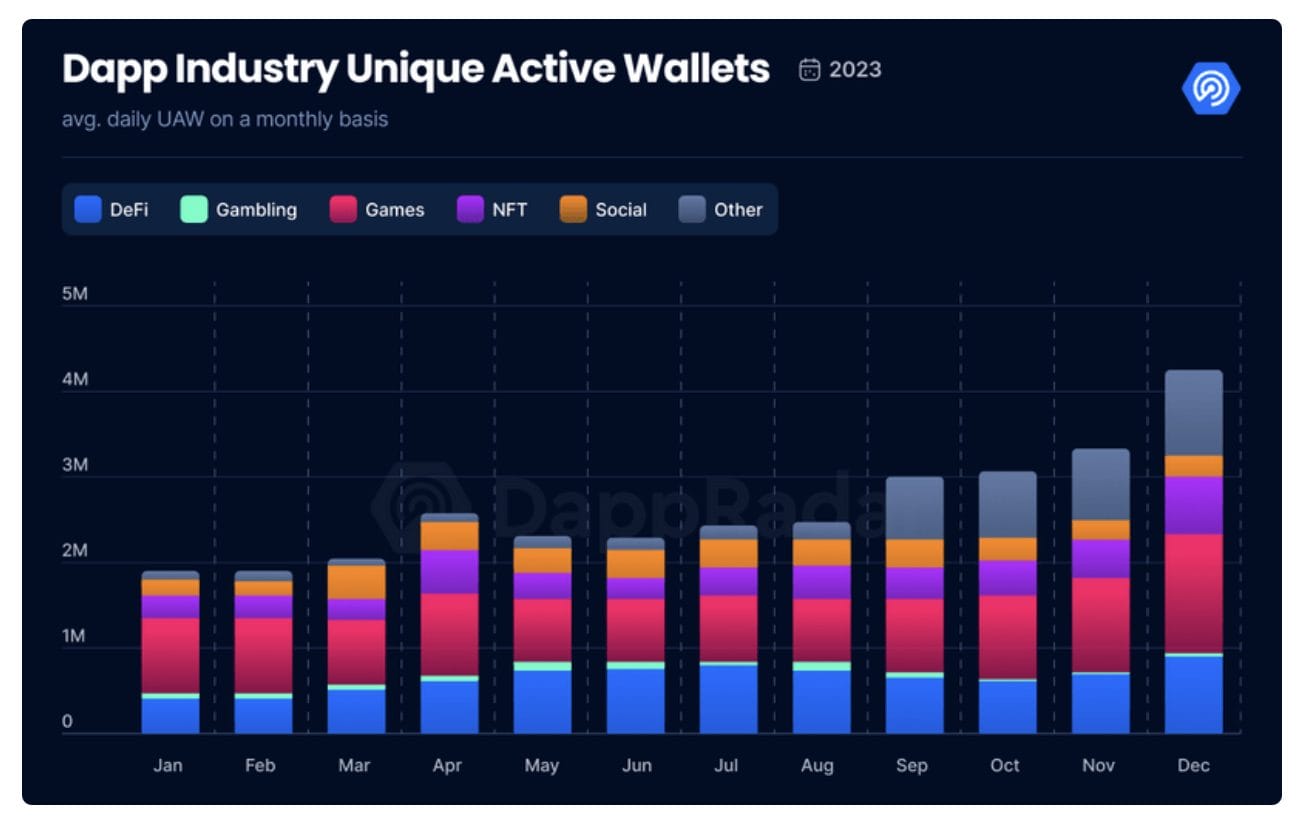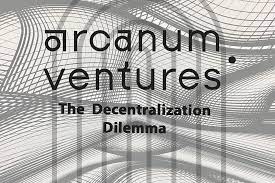Web3 games remain at the forefront of on-chain engagement. As outlined in DappRadar’s latest Game Report, blockchain games constituted 34% of decentralized application (Dapp) activity in the previous year. Additionally, the report highlights that Web3 games amassed 1.1 million active daily users throughout 2023.

Despite their significance, blockchain games encounter hurdles in captivating both traditional and Web3 gamers, as underscored in the 2023 State of the Industry Report by the Blockchain Game Alliance (BGA).
The report illuminates the persistent struggle surrounding onboarding and accessibility for blockchain games, a challenge that loomed large in 2022. In fact, the survey conducted by the BGA revealed that 51% of respondents identified onboarding as the foremost concern. Regrettably, this trend persisted in the subsequent year, with 55.1% of respondents still highlighting onboarding as a primary challenge.
The findings from the BGA’s report shed light on the ongoing impediments faced by blockchain games, indicating a pressing need for concerted efforts to address issues related to onboarding and accessibility in order to foster broader adoption and engagement within both traditional and Web3 gaming communities.
📢 The much-anticipated BGA State of the Industry Report 2023 is LIVE! 🎉
The annual BGA Survey Report, in collaboration with @emfarsis & @DappRadar, takes the pulse of the industry in 2023 & looks to the year ahead! 🚀
💡 Dive into the insights here 👇https://t.co/zql9U7OT67 pic.twitter.com/WSE1oJb10Y
— Blockchain Game Alliance (@BGameAlliance) December 13, 2023
Challenges Unique to Web3 Games
Dean Takahashi, Lead Writer for GamesBeat at VentureBeat, conveyed to Cryptonews that Web3 games encounter considerably more resistance compared to their Web2 counterparts.
“Web2 games benefit from a decade of familiarity among gamers,” Takahashi noted. “For instance, Web2 gamers are accustomed to making in-app purchases seamlessly within apps downloaded from app stores.”
Takahashi highlighted that Web3 games face visibility constraints due to app store regulations.
“Web3 games have only recently gained entry into app stores through a hybrid Web2/Web3 model,” he explained. “However, this model is still subject to app store policies, which prioritize monetization through a 30% royalty on in-app purchases.”
It’s essential to recognize that this model contradicts the decentralized ethos inherent in Web3 games.
Takahashi also underscored the monetization obstacles encountered by blockchain games due to the limitations on cryptocurrency payments. This presents additional hurdles for Web3 players seeking to engage with mobile platforms.
“Establishing a crypto wallet can be a complex and daunting process,” he emphasized. “All of these factors contribute to friction that dissuades all but the most tech-savvy gamers from proceeding.”
Furthermore, Takahashi pointed out that game companies are unable to direct players to make purchases off-store on their own websites for crypto transactions, further complicating the monetization landscape for Web3 games.
Enhanced Discoverability Facilitates the Adoption of Web3 Games
Amidst these persistent challenges, Takahashi posits that the advancement of Web3 games hinges on their ability to become more discoverable to their target audience.
“Web3 games need to connect with Web3 gamers,” he asserted.
This sentiment is echoed in the Blockchain Game Alliance’s (BGA) 2023 State of the Industry Report, which underscores the importance of user acquisition and retention as pivotal metrics for fostering game growth.
In contrast to Web2 games, which often rely on the collection of personal user data, and leverage advertising models across centralized social media platforms that harvest personal information, the integration of such methods proves intricate for Web3 games. This complexity arises from the fact that user data in Web3 games remains anonymous, and blockchain games operate within decentralized ecosystems where data collection must occur on-chain.
Analyzing Data for Web3 User Acquisition
While grappling with data analytics poses a challenge for Web3 games, Anton Umnov – CEO and Co-Founder of Helika – emphasized to Cryptonews that the widespread adoption of blockchain games hinges on the creation of captivating gaming experiences.
To address this crucial need, Umnov revealed that Helika, a leading provider of data analytics and infrastructure solutions for the gaming sector, has recently introduced Helika Accelerate. This innovative platform is tailored to furnish gaming studios with specialized engagement data.
“Helika Accelerate combines top-tier analytics with artificial intelligence-driven live operations solutions, pairing promising Web3 games with comprehensive analytics,” explained Umnov.
Umnov underscored the pivotal role of user-generated data analytics in enhancing player engagement and boosting lifetime value (LTV), a vital revenue metric for game developers.
“Traditional game studios leverage analytics to pinpoint the right audience by analyzing player behavior and preferences, thereby optimizing marketing strategies, targeting promising user segments, and crafting personalized player experiences through live operations,” he elucidated.
Moreover, Umnov highlighted a prevalent challenge faced by many Web3 game studios: while they may excel in attracting initial interest, sustaining long-term growth often proves elusive due to insufficient data optimization.
Adopting Decentralization for User Acquisition
While the challenges surrounding data acquisition in Web3 games are significant, there are indications that blockchain technology could offer innovative solutions in a decentralized fashion.
One such avenue is highlighted in the BGA report, which discusses the concept of “on-chain targeting.” This approach enables gaming studios to utilize on-chain player data, allowing developers to craft more immersive and engaging gaming experiences. The report underscores that leveraging on-chain activity data can offer valuable insights into player preferences, such as their inclination towards play-to-earn games or RPGs.
Anton Umnov, CEO and Co-Founder of Helika, emphasized the significance of tapping into on-chain data as part of their analytics strategy. He explained how Helika harnesses publicly available on-chain data to generate actionable insights that gaming studios can leverage to attract new users.
Additionally, Idan Zuckerman, Co-CEO and Co-founder of Upland, shed light on how their blockchain-based game utilizes in-game data for user acquisition purposes. He clarified that the data collected pertains to users’ interactions within the game rather than personal information. By analyzing user behavior, Upland can segment its user base and tailor experiences to meet diverse preferences. Zuckerman illustrated this approach with a concrete example, highlighting how insights gleaned from data analysis prompted adjustments to their NFL player association product, resulting in significant improvements in ownership and engagement metrics.
These examples underscore the potential of blockchain technology to revolutionize user acquisition strategies in the gaming industry by offering decentralized data solutions that prioritize user privacy and enhance gaming experiences based on actionable insights derived from on-chain activities.
Alternative Approaches to Enhancing User Acquisition for Web3 Games
While data analytics undoubtedly holds promise for enhancing user acquisition in the gaming industry, it’s important to acknowledge the growing concern among gamers regarding the privacy of their personal information.
Gabi Musayev, the Director of Marketing at Galxe, emphasized the significance of preserving user privacy in the gaming realm. He noted that the majority of consumers, especially gamers, are wary of having their data exploited or misused. To address this, Musayev proposed the integration of zero-knowledge technology at the protocol layer of Web3 games. This approach would allow for the secure storage and transmission of user data while ensuring that it remains inaccessible to unauthorized parties.
In addition to safeguarding user privacy, the adoption of artificial intelligence (AI) is poised to revolutionize user acquisition strategies in the gaming sector. Straith Schreder, Chief Creative Officer of Candy Digital, highlighted the pivotal role that AI is expected to play in driving the growth of Web3 games. Schreder emphasized that AI has the potential to revolutionize personalization in gaming experiences, thereby enhancing user engagement. Specifically, he pointed to Procedural Content Generation (PCG) as a key AI-driven technique that enables the creation of dynamic game content tailored to individual player preferences. By leveraging AI-powered analytics, gaming studios can gain deeper insights into user behavior in real-time, allowing for more effective user acquisition and retention strategies.
Schreder further underscored the transformative impact of AI-driven personalization, noting that it has the potential to redefine digital identity in gaming. With enhanced personalization, players can enjoy more expressive, diverse, and experimental gaming experiences, ultimately fostering greater fluidity and immersion within the gaming ecosystem.



